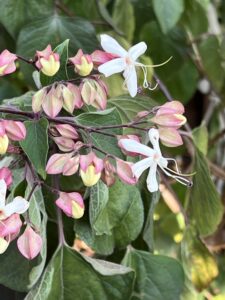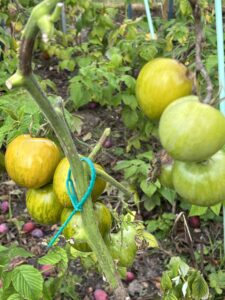September rolled in with the baking heat of summer we had all been waiting for. With September comes the fiery colours of orange and yellow: ginger lily, further blasts of titonia and yellow rudbeckia lighting up the back corners of the border. Our sedum sulked through August and are now finally in full bloom too. With dahlia and salvia still going strong, this all feels like bees are gorging on nectar and pollen everywhere. Now birds have finished nesting, September is the month of hedge pruning. We decided to cut back our climbing roses along our border fence, which have grown straggly and frequently snap during stormy weather. The extra light created with cutting back has given even more incentive for plants to rejuvenate.

I am always in search of interesting new plants for the border to flower in each month. Five Septembers ago, we were taking a walk in London’s Hyde Park and we turned a corner and were stopped in our tracks by an amazing jasmine-like perfume. The source turned out to be a small, rather boring, looking bush called clerodendrum trichotomum. (An impossible name to remember, so I call it “Hyde Park” when asked by any visitors). It has resented my placement of it in a hidden border, and has really not liked our dry, windy climate in Rye, resulting in four years of no flowers, little growth and a “are you worth having?” kind of relationship. But patience pays off in gardening. This year, it was the buzzing of bumble bees which alerted me back to it and Hyde Park is finally flowering and gorgeous. I shall now prune it into a nicer shape once the bloom is finished, and feed it just to show I do care after all that it survives.
Our allotments has been a very mixed bag of results this year. Apples and pears are laden with fruit. With produce overload, South Undercliff Allotments decided it was high time for a late season social gathering. “Bring your own”, one warm Saturday afternoon, resulted in a delicious sharing feast including veggie chilli, curry and pizza with cake and cookies for dessert.
 The bad news is the return for us of tomato blight. The increased humidity has helped to spread this awful fungal disease. It attacks quickly and can turn especially older, exhausted plants black. For us, our plants were heavy with large fruit just starting to ripen. Tell-tale signs of withering leaves and discoloured brown fruit means quick action. We managed to save a few plants and their fruit by stripping all leaves and removing all infected plants. These cannot be composted but bagged up and taken away for disposal. These kinds of diseases can be managed by rotating crops each year. “Better luck next year” continues to be a gardener’s optimistic motto.
The bad news is the return for us of tomato blight. The increased humidity has helped to spread this awful fungal disease. It attacks quickly and can turn especially older, exhausted plants black. For us, our plants were heavy with large fruit just starting to ripen. Tell-tale signs of withering leaves and discoloured brown fruit means quick action. We managed to save a few plants and their fruit by stripping all leaves and removing all infected plants. These cannot be composted but bagged up and taken away for disposal. These kinds of diseases can be managed by rotating crops each year. “Better luck next year” continues to be a gardener’s optimistic motto.
Finally, a little apology. In August, I posted a lovely picture I saw in the Rye Flower Show – and mislabelled the artist. So, apologies to Kevin Hall – his picture came 2nd in its category. And credit to the “real” picture by Xavier Baynton Here is his own submission, which certainly deserves a mention.
Image Credits: Abigail Cooper-Hansen , Xavier Bayntun .



